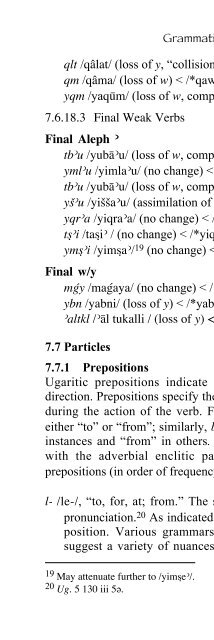A Primer on Ugaritic: Language, Culture, and Literature - enenuru
A Primer on Ugaritic: Language, Culture, and Literature - enenuru
A Primer on Ugaritic: Language, Culture, and Literature - enenuru
Create successful ePaper yourself
Turn your PDF publications into a flip-book with our unique Google optimized e-Paper software.
Grammatical Précis 177<br />
qlt /qa®lat/ (loss of y, “collisi<strong>on</strong>” of vowels) < *qayalat (qatalat)<br />
qm /qa®ma/ (loss of w) < /*qawama/ (qatala)<br />
yqm /yaquœm/ (loss of w, compensatory length) < /*yaqwum/<br />
7.6.18.3 Final Weak Verbs<br />
Final Aleph }<br />
tb}u /yubaœ}u/ (loss of w, compensatory length) < /*tubwa}u/<br />
yml}u /yimla}u/ (no change) < *yimla}u (yiqtalu)<br />
tb}u /yubaœ}u/ (loss of w, compensatory length) < *tubwa}u<br />
ysû}u /yisûsûa}u/ (assimilati<strong>on</strong> of n) < /*yinsûa}u/ (yiqtalu)<br />
yqr}a /yiqra}a/ (no change) < /*yiqra}u/ (yiqtala)<br />
ts}i /tasi} / (no change) < /*yiqra}u/ (taqtil)<br />
yms}i /yimsa}/ 19 (no change) < /*yimsa}/ (yiqtal)<br />
Final w/y<br />
mgíy /magíaya/ (no change) < /*magíaya/ (qatala)<br />
ybn /yabni/ (loss of y) < /*yabiy/ (yaqtil)<br />
}altkl /}aœl tukalli / (loss of y) < /*tukalliy/ (tuqattil)<br />
7.7 Particles<br />
7.7.1 Prepositi<strong>on</strong>s<br />
<strong>Ugaritic</strong> prepositi<strong>on</strong>s indicate positi<strong>on</strong>. <strong>Ugaritic</strong> verbs denote<br />
directi<strong>on</strong>. Prepositi<strong>on</strong>s specify the positi<strong>on</strong> of their object before or<br />
during the acti<strong>on</strong> of the verb. For example, l- may be translated<br />
either “to” or “from”; similarly, b- must be translated “in” in some<br />
instances <strong>and</strong> “from” in others. Often, a prepositi<strong>on</strong> will appear<br />
with the adverbial enclitic particle -m. The major <strong>Ugaritic</strong><br />
prepositi<strong>on</strong>s (in order of frequency) are as follows:<br />
l- /le-/, “to, for, at; from.” The syllabic writing le-e indicates the<br />
pr<strong>on</strong>unciati<strong>on</strong>. 20 As indicated, the base meaning has to do with<br />
positi<strong>on</strong>. Various grammars, <strong>and</strong> the exercises above, may<br />
suggest a variety of nuances, such as, moti<strong>on</strong>, locality, time,<br />
19 May attenuate further to /yimse}/.<br />
20 Ug. 5 130 iii 5´.


